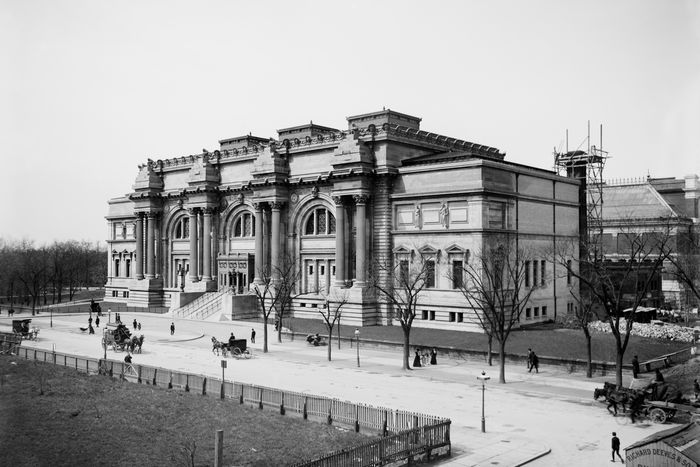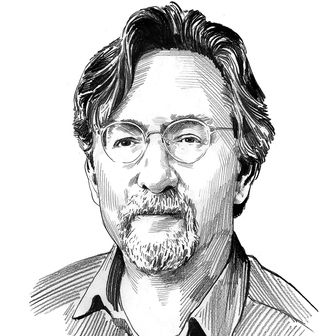
The Metropolitan Museum is not a building but a city of art. It invites visitors to lose themselves, bump up against dead ends, double back, ask for directions, and get gloriously disoriented again, not just in space but in time. Walk past Italian Baroque sculptures and you wind up in Africa. Just beyond American 18th-century furniture is Japanese calligraphy. Like a genuine metropolis, the Met expanded according to grand plans that were rarely honored and frequently adjusted to conform with expediency and improvisation. As it grew, it acquired a sequence of barely compatible architectural styles, opportunistically mashed together. The first visitors in 1880 knew only a small Gothic building in Central Park, designed by Calvert Vaux and Jacob Wrey Mould. It’s still there but nearly invisible now, swallowed up by later additions. The expanding museum reached Fifth Avenue in 1902 with Richard Morris Hunt’s Great Hall, where dignity and exuberant splendor still meet. Over time, new buildings kept attaching to others like barnacles, so façades had second careers as interior walls, windows turned into hallways, and passageways became bathrooms. The architect Frida Escobedo recently produced a wooden model of the whole complex that comes apart into 23 separate three-dimensional puzzle pieces. Assembling them correctly could keep a precocious child occupied all afternoon. Escobedo’s job has been to replace the real-life counterpart of one of those blocks — the dispiriting and awkward modern-and-contemporary-art wing at the museum’s southwest corner — with a new home for its growing collection of 20th- and 21st-century art. The Met will never be finished, but her piece of it (officially the Oscar L. Tang and H.M. Agnes Hsu-Tang Wing for Modern and Contemporary Art) is the museum’s most ambitious construction project in decades — and probably for decades to come.
The design, which is about to embark on its obligatory 18-month journey in search of all the necessary approvals, looks laudably simple because it provides an elegant solution to a tangle of trade-offs and constraints. The galleries had to grow by 50 percent without creeping so much as an inch further into Central Park. The new wing needed more height that also must remain essentially unseen from the park. Walls must allow for more daylight and park views but without shortchanging space for paintings. The floors had to be continuous with the rest of the museum but also needed to be spaced to provide those generous ceiling heights. And so on; the tensions piled up. Most of all, the new wing had to achieve a level of architectural excellence worthy of both the institution and the reputation of a brightening superstar — without distracting from the whole. After all, Escobedo’s assignment was to design not an entrance but the museum’s back end.
Escobedo is one of Mexico’s most visible architects but an unorthodox choice for a Knickerbocker institution and a custodian of global cultural history. Her breakout project was La Tallera, a 2010 expansion of the artist David Alfaro Siqueiros’s studio in Cuernavaca, where she suspended two large murals on tilted frames over a courtyard, merging art and open space in a dramatic gesture. Her most recent work is a stylish but more muted condo building in Brooklyn. At the Met, she is hoping to bring together the various strands of her practice — sophisticated and cosmopolitan yet rooted in a Mexican vernacular, expressive but not self-indulgent, pragmatic yet poetic.


She’s almost there — or, rather, she’s almost almost there. The design’s a long way from its final refinement: There are missing details and decisions, and the renderings we’re seeing reflect that haziness. But even now, it’s clear that Escobedo’s team has produced interior plans of luminous rationality, creating galleries that are simultaneously distinct and flexible and knitting the future wing into the rest of the museum so that you can enter a high-ceilinged room and experience a burst of majesty — or slide in from an old building and hardly notice the transition. Daylight suffuses some spaces and is banished from others. Nobody can predict how art will morph in the next century — satellite-based sculpture? Micromanuscripts? — or what kind of institutional habitats it will require. Many museums meet that unknown by opting for one or two big boxes that can be divided up with temporary walls and constantly reconfigured (at significant financial and environmental cost). The Met, on the other hand, is betting that variety beats flexibility or, rather, that variety is flexibility. Whatever artists come up with, they’ll always have the right room or outdoor terrace.
A new museum wing here can’t just be an exercise in logistics. It’s also a presence in Central Park and a half-billion-dollar embodiment of the museum’s encyclopedic mission. Physical connections to other parts of the complex reflect the interlinked traditions it contains. When the adjacent Rockefeller Wing reopens in May, for instance, it will reintroduce the public to artworks from Africa and Oceania that date from the same period as Henri Matisse and, in some cases, exerted a profound influence on European painting and sculpture. Objects and visitors will be able to shuttle back and forth between those two zones, telling a story of complex exchange. At the same time, contemporary art is the one kind that keeps changing, so in this grand repository of civilization’s history, the new wing must be conceived as an open-ended vessel of the future.
To articulate those connections, Escobedo has drawn loosely on the precedents of pre-Columbian Latin America. The structure steps back from the park in terraced chunks, like ancient hilltop cities in Yucatán and Peru. There’s a certain logic to this: Beaux-Arts acropolis out front, modern Indigenous temple at the back. On Escobedo’s new façade, a vertically striated shell of rough limestone wraps four levels of galleries, and the ribs and channels recall the elaborate reliefs carved in those Mayan blocks of rock. There’s a strong link between Mexico’s tradition of stonework and its textiles: The same patterns crop up in ruins and rugs, and it’s hard to know which came first. That parallelism also exists in Escobedo’s nubbly façade, which resembles a coarse wool blanket, woven to look at once ancient and modern, organic and geometric.
The threads in Escobedo’s weave are lengths of limestone, evenly spaced with gaps in between, against a backing that is mostly opaque but occasionally clear. In see-through sections, the wall becomes a screen, giving passersby glimpses into the galleries and visitors segmented views onto the park. The porous screen that serves to tame sunlight takes many forms around the world — the Islamic mashrabiya; the brise-soleil, in the terminology of Le Corbusier; and the celosia in Latin America — and it has long been crucial to Escobedo’s imagination. In 2018, she erected a Serpentine Pavilion in London that enclosed outdoor rooms with roof tiles stacked and staggered into a substantial mesh. Here, the screen serves to connect the museum with the enfolding park and keep the two separate at the same time. (Not all the openings are screened; some are just glass.)
This is where the design still feels undercooked, at least when seen from outside. The stone slats get thinner and more tightly spaced as the building rises, accentuating the sense of perspective. But they don’t vary on the horizontal axis so that, on each level, the rhythm of stone and space remains unchanging as you walk by. As Escobedo recently took me through the thinking and the images that inspired her, she paused on a Sol LeWitt drawing from 1972 (Successive Rows of Horizontal Straight Lines From Top to Bottom and Vertical Straight Lines From Left to Right) in which the grid loosens and tightens as your eye moves diagonally across the page. For a moment, I thought she was after a similarly dynamic effect, an architectural-scale shimmer that would make the building appear less like a cage. But she corrected me: Variety is not what she’s looking for on the façade. In the balance between grace and monumentality, Escobedo has doubled down on the minimal and monolithic.
Escobedo’s new Tang Wing will take the place of the Lila Acheson Wallace Wing, designed by Kevin Roche and completed — sort of — in 1987. From the beginning, it projected all the glamour of a concrete warehouse plunked amid the verdure. Inside, it provided haphazard spaces for the Met’s spotty modern-art collection—a tangle of mezzanines, stairways and wrong turns. “I was never very happy with what happened,” Roche admitted to the New York Times a decade ago. (He died in 2019 at 96.) “There wasn’t a clear program, and it kind of just got put together in pieces.” This time, things are different. In 2013, the cosmetics magnate Leonard Lauder presented the Met with $1 billion worth of Cubist paintings (78 in all) — by itself a powerful incentive to build them a worthy home. The museum initially gave the task to David Chipperfield, but that project collapsed. Now it finally has the clarity, the contents, and the money to go with its desires.
I wonder, though, whether the current state of the design represents an institution that’s been left jittery by past setbacks and missteps. At the start of the 20th century, when New York was at the height of its blustering insecurity and the Met was still getting on its feet, Hunt threw everything he had at the Fifth Avenue façade. Rising above the great staircase is a builder’s catalogue of pilasters, cornices, corners, lion’s heads, dentils, robed muses, medallions, scrolls, and arched niches. Roche, for decades the Met’s master planner and resident architect, answered all that excess by encircling the complex with severe walls of glass and blocks of concrete. Escobedo returns to a love of lively surfaces, but she dials the drama down to a whisper. There are no bundles of exclamation points, no Gilded Age magniloquence, no insistence that, yes, Americans can be cultured, too. The Met is now one of the world’s two or three greatest museums — arguably the greatest — and its status doesn’t require a boost from Escobedo. She can design at a murmur instead of a shout. But there’s such a thing as too much restraint. Mayan and Incan ruins are nothing if not dramatic: Their stairs are steep, their drops precipitous, their bulk imposing, their carvings ferocious and ornate. Escobedo dips into two rich and colorful histories — Latin America’s and the Met’s — then blends them into a product that will sit politely on the Upper East Side, promising never to offend.





